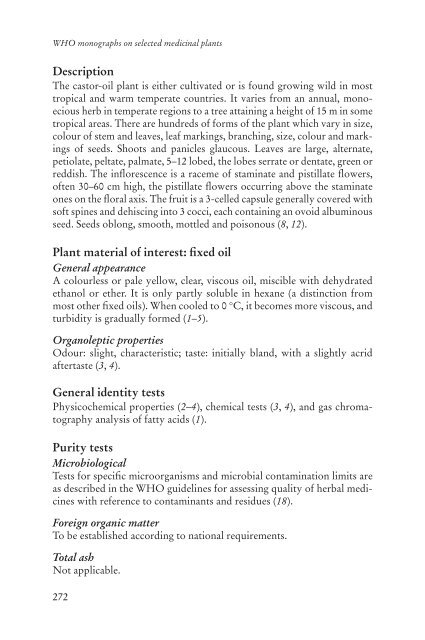WHO monographs on selected medicinal plants - travolekar.ru
WHO monographs on selected medicinal plants - travolekar.ru
WHO monographs on selected medicinal plants - travolekar.ru
Create successful ePaper yourself
Turn your PDF publications into a flip-book with our unique Google optimized e-Paper software.
<str<strong>on</strong>g>WHO</str<strong>on</strong>g> <str<strong>on</strong>g>m<strong>on</strong>ographs</str<strong>on</strong>g> <strong>on</strong> <strong>selected</strong> <strong>medicinal</strong> <strong>plants</strong><br />
Descripti<strong>on</strong><br />
The castor-oil plant is either cultivated or is found growing wild in most<br />
tropical and warm temperate countries. It varies from an annual, m<strong>on</strong>oecious<br />
herb in temperate regi<strong>on</strong>s to a tree attaining a height of 15 m in some<br />
tropical areas. There are hundreds of forms of the plant which vary in size,<br />
colour of stem and leaves, leaf markings, branching, size, colour and markings<br />
of seeds. Shoots and panicles glaucous. Leaves are large, alternate,<br />
petiolate, peltate, palmate, 5–12 lobed, the lobes serrate or dentate, green or<br />
reddish. The inflorescence is a raceme of staminate and pistillate flowers,<br />
often 30–60 cm high, the pistillate flowers occurring above the staminate<br />
<strong>on</strong>es <strong>on</strong> the floral axis. The f<strong>ru</strong>it is a 3-celled capsule generally covered with<br />
soft spines and dehiscing into 3 cocci, each c<strong>on</strong>taining an ovoid albuminous<br />
seed. Seeds obl<strong>on</strong>g, smooth, mottled and pois<strong>on</strong>ous (8, 12).<br />
Plant material of interest: fixed oil<br />
General appearance<br />
A colourless or pale yellow, clear, viscous oil, miscible with dehydrated<br />
ethanol or ether. It is <strong>on</strong>ly partly soluble in hexane (a distincti<strong>on</strong> from<br />
most other fixed oils). When cooled to 0 °C, it becomes more viscous, and<br />
turbidity is gradually formed (1–5).<br />
Organoleptic properties<br />
Odour: slight, characteristic; taste: initially bland, with a slightly acrid<br />
aftertaste (3, 4).<br />
General identity tests<br />
Physicochemical properties (2–4), chemical tests (3, 4), and gas chromatography<br />
analysis of fatty acids (1).<br />
Purity tests<br />
Microbiological<br />
Tests for specific microorganisms and microbial c<strong>on</strong>taminati<strong>on</strong> limits are<br />
as described in the <str<strong>on</strong>g>WHO</str<strong>on</strong>g> guidelines for assessing quality of herbal medicines<br />
with reference to c<strong>on</strong>taminants and residues (18).<br />
Foreign organic matter<br />
To be established according to nati<strong>on</strong>al requirements.<br />
Total ash<br />
Not applicable.<br />
272

















